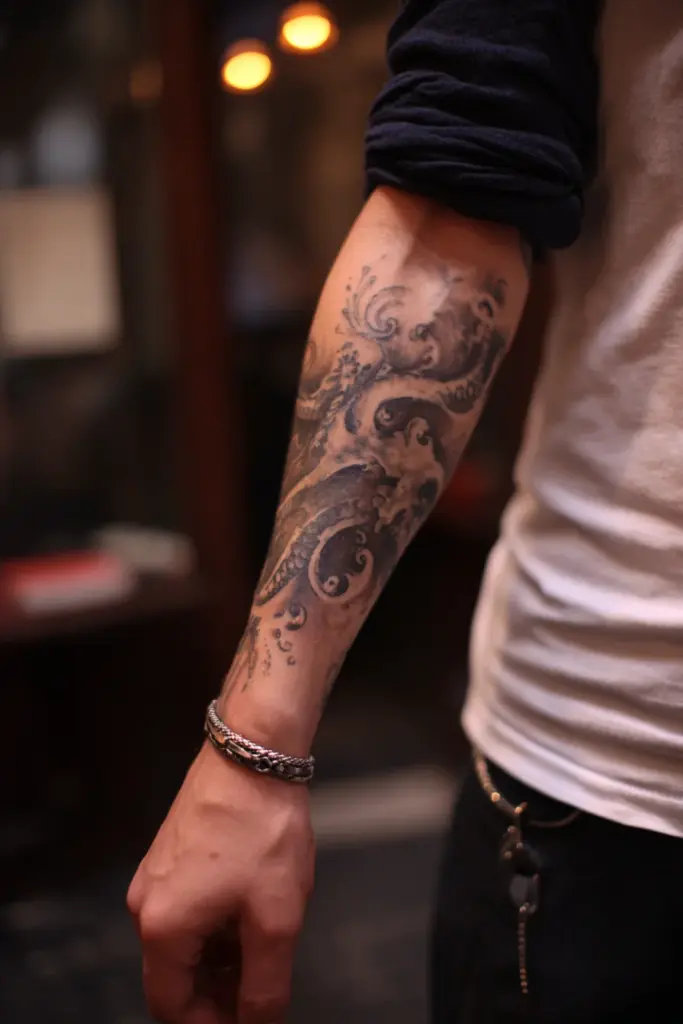Hi, I’m Hakan — a tattoo consultant and designer with 10+ years working across studios and custom projects. In this post I present 16 curated forearm sleeve tattoo ideas for men, gathered from client briefs, portfolio builds and trend research. Forearm sleeves suit men who want a visible, wearable statement that can still be partially covered for work or formal settings. They work well with both blackwork and color, and adapt to straight or rounded forearms. Practical tips I rely on: plan the composition from elbow to wrist, pick a clear focal element, allow negative space for flow, match style to your lifestyle, and consult an artist for sizing and skin-tone adjustments. Use reference images (I include 16 visuals in the gallery) to communicate ideas, and prioritize an artist whose portfolio shows consistent sleeve work rather than individual flash pieces.
Black & Grey Japanese Dragon Forearm Tattoo
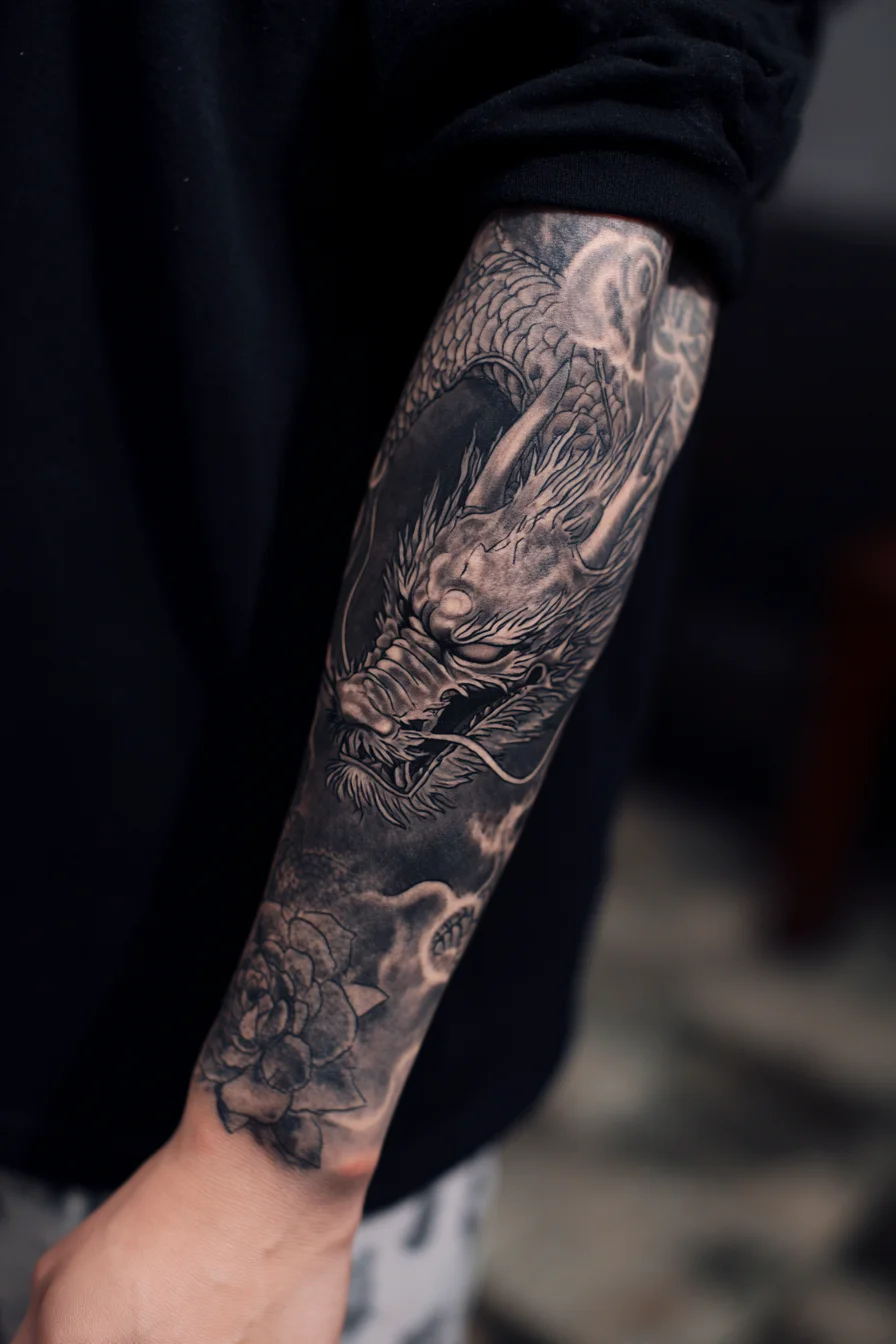
This black-and-grey Japanese dragon forearm piece reads as a classic symbol of strength, protection and wisdom — a masculine, timeless motif that pairs well with floral elements like peony or lotus for balance. The elongated composition follows the natural line of the forearm, making it ideal as a standalone half-sleeve or the beginning of a full sleeve that can wrap toward the shoulder or chest. Expect pain to be low-to-moderate along the outer forearm where flesh is thicker; sensitivity increases on the inner forearm, near the wrist, and over bony areas by the elbow. For crisp scales and facial detail, plan for a medium-to-large layout (roughly 6–10 inches long and 3–5 inches across) so shading and texture won’t blur as it heals. Styling variations include high-contrast blackwork, soft greywash realism, traditional irezumi color accents (reds/golds), or negative-space clouds and dotwork backgrounds for a modern edge. Discuss line weight, contrast, and skin tone with your artist to ensure longevity and legibility. Proper aftercare and touch-ups keep the piece bold over time.
Blackwork Tribal Sleeve Tattoo — Masculine Arm Sleeve Design
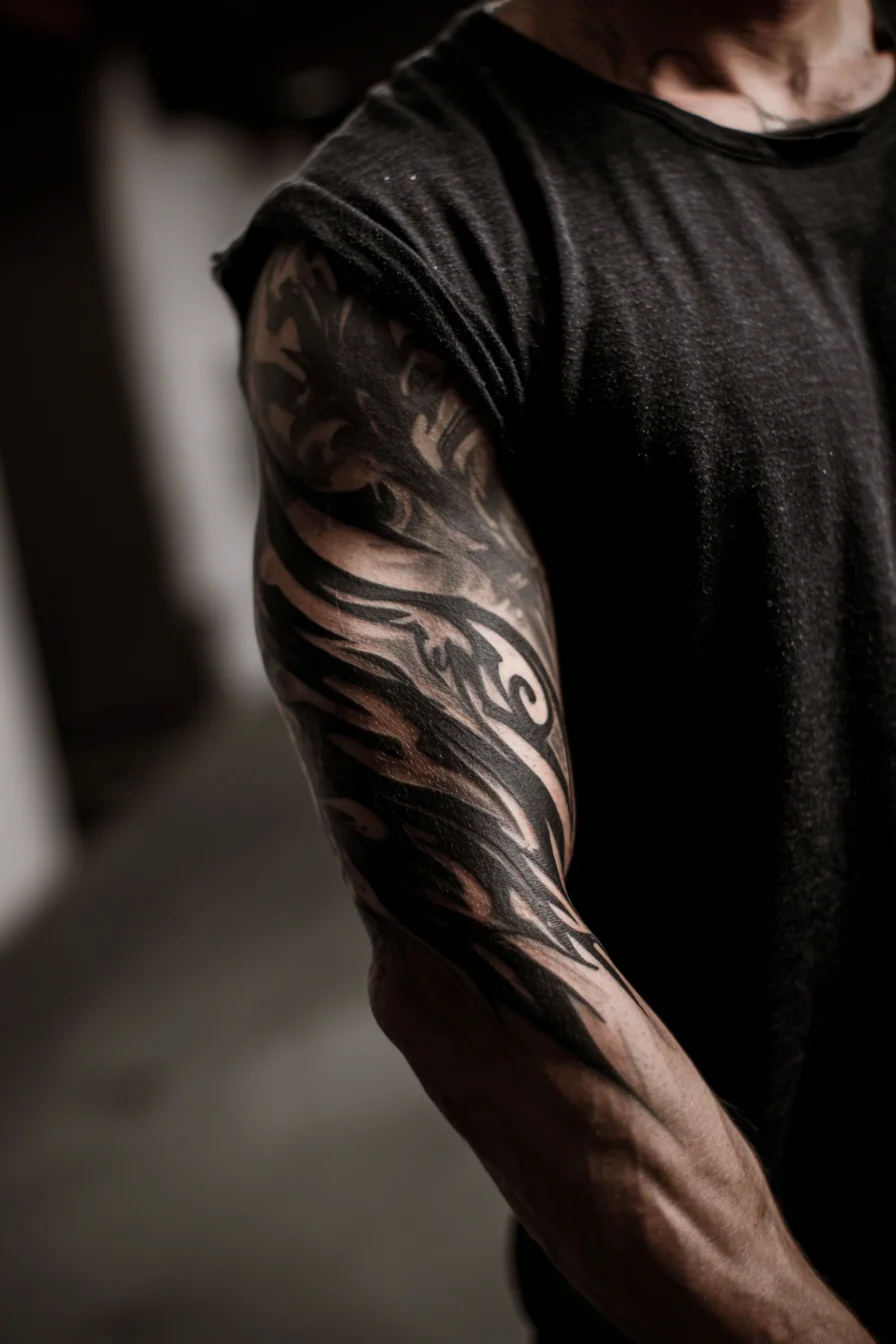
This bold blackwork tribal sleeve combines flowing, flame-like lines and solid negative space to create a dynamic, masculine statement. The design suggests strength, movement and protection and can be personalized with cultural motifs or personal milestones. Placement options include a full sleeve (shoulder to wrist), a half sleeve (mid-bicep to wrist), a bicep wrap, or an extension across the chest and shoulder for continuity. Expect varied pain levels: the outer bicep and tricep are relatively mild, while the inner arm, elbow crease, wrist and tendon areas are more sensitive; long sessions may increase soreness, so plan multiple appointments. Size should be scaled to your arms anatomy — larger compositions keep crisp edges and allow negative space to breathe, while smaller pieces require simplified linework. Styling variations include pure black tribal/Polynesian patterning, black-and-gray shading for depth, dotwork textures, selective color highlights, or integration with realism (animals, skulls) and geometric elements. Discuss session pacing and touch-up strategy with your artist to ensure healing, preserve bold contrast, and maintain longevity.
Realistic Lion and Pocket Watch Forearm Tattoo — Strength & Timelessness
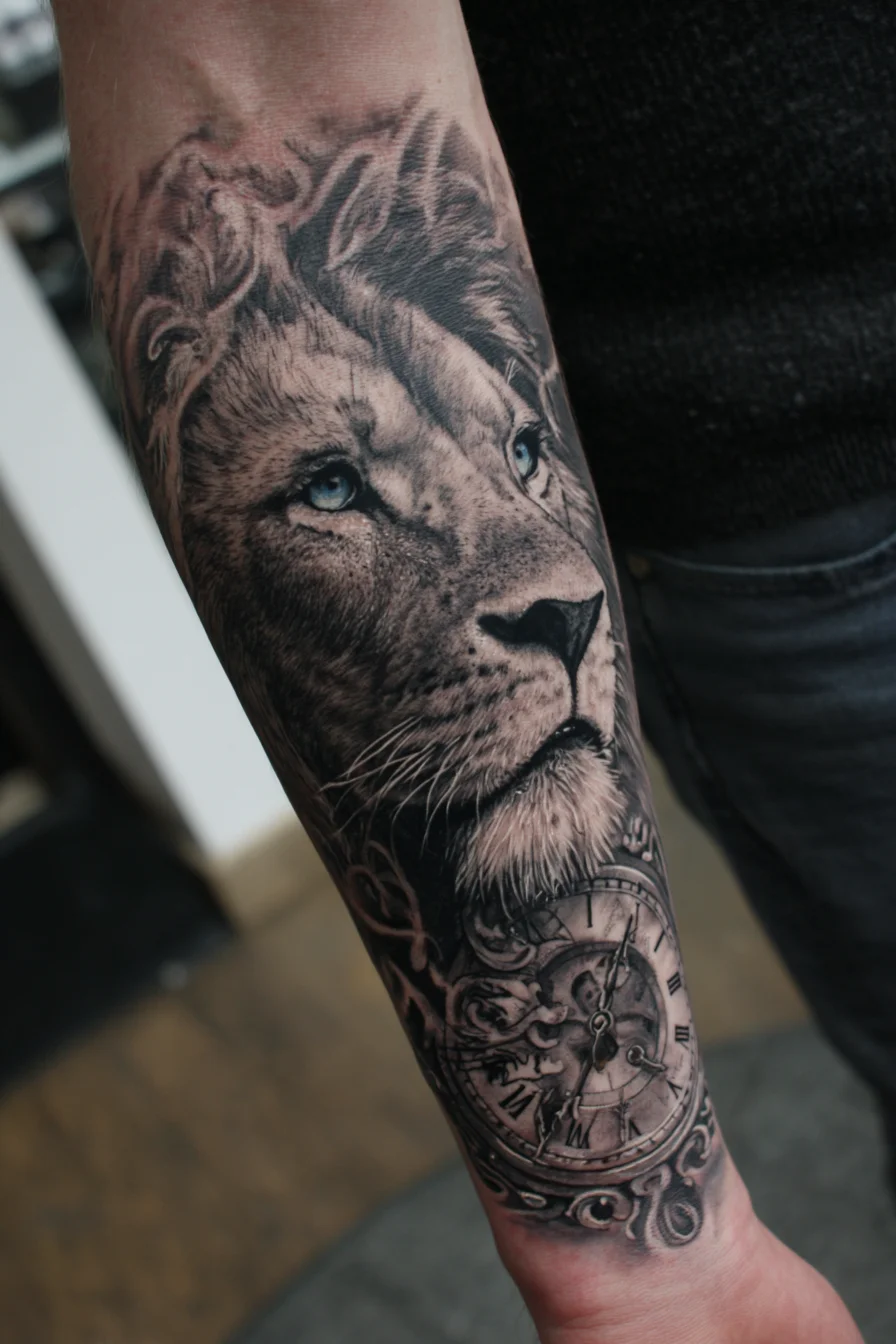
This black-and-grey realistic design pairs a lion’s portrait with an ornate pocket watch to convey courage, leadership, and the passage of time — a popular choice for men wanting a bold, symbolic piece. The lion represents strength, protection and personal authority; the clock can symbolize legacy, mortality, or a moment of significance. Placement suggestions: the outer or inner forearm is ideal for visibility and flow; the composition also adapts well to a half- or full-sleeve, upper arm, or chest extension. Pain expectations: forearm tattoos are generally moderate in pain—outer forearm is more tolerable, while the inner forearm, wrist and near the elbow are more sensitive. Expect multiple sessions for dense shading and fine detail. Size considerations: realistic faces and clock mechanics require scale to retain detail—plan at least a medium vertical panel (roughly 6–10 inches) for crisp features. Styling variations: keep it classic black-and-grey realism, add a selective color accent (e.g., blue eyes), integrate geometric frames, dotwork backgrounds, or script/dates on the clock hands. Consult an experienced realism artist to refine scale, contrast and aftercare for longevity.
Black-and-Grey Octopus Tentacle Forearm Tattoo — Nautical Sleeve Accent
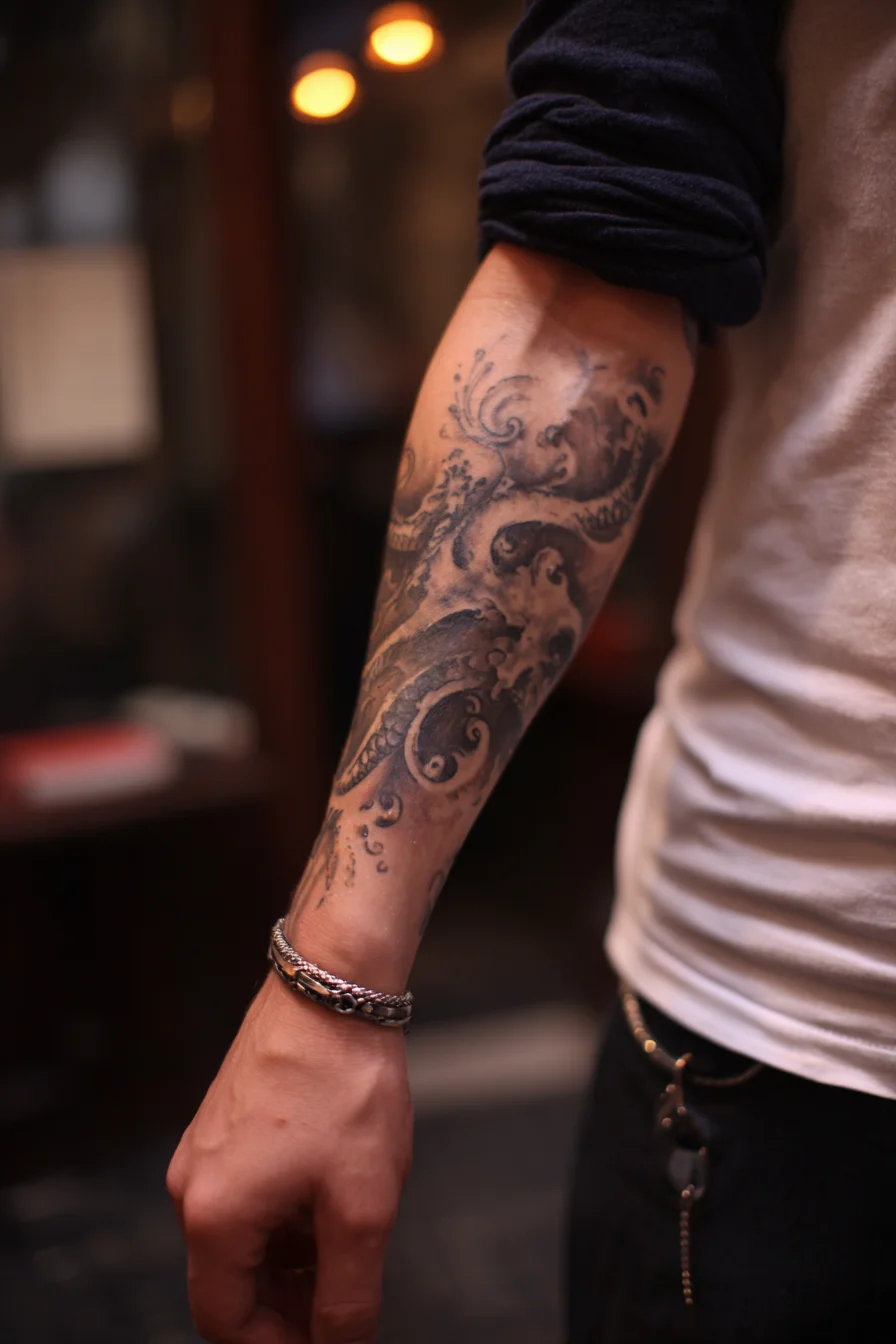
This black-and-grey octopus tentacle forearm tattoo blends organic movement and marine symbolism — resilience, adaptability, and quiet intelligence. The flowing tentacles create natural lines that wrap the forearm, making this design ideal for an outer or full forearm sleeve and easy to extend toward the elbow, bicep, or wrist. Expect a moderate pain level overall: the fleshy outer forearm is one of the more tolerable spots, while areas closer to the wrist and elbow get noticeably more sensitive. For clarity of the swirling suckers and water texture, choose at least a medium canvas (roughly 6–8 inches/15–20 cm length) so fine shading and negative-space highlights hold over time; small, compressed versions will lose detail. Styling variations include high-contrast realism, dotwork or stippling for texture, neo-traditional linework for a bolder masculine look, or selective color accents (deep blues/teal) to emphasize water movement. Work with an artist experienced in flow and anatomy to ensure the tentacles follow muscle lines, and plan for standard aftercare and sun protection to preserve the grayscale shading.
Realistic Stag Forearm Tattoo — Black & Gray Deer Portrait with Woodland Background
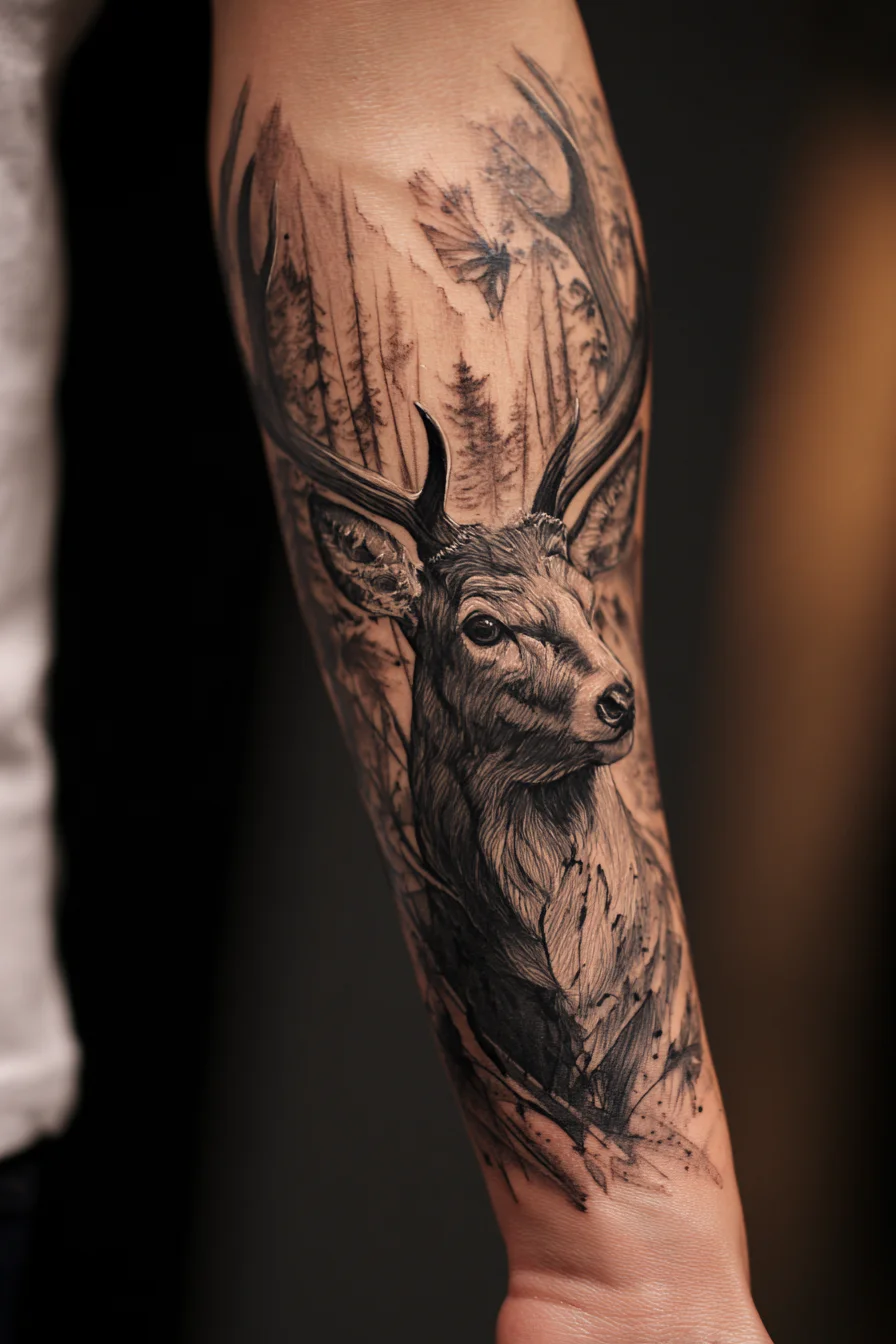
This realistic stag forearm tattoo blends a detailed deer head with a whispering forest background to represent strength, leadership, and a connection to the outdoors—qualities many men choose to express through body art. Placement recommendation: outer forearm for maximum visibility and natural musculature flow; inner forearm offers a more personal placement but can be more sensitive. Pain expectations: outer forearm is typically low-to-moderate in pain, while inner forearm, near the wrist, and over bony areas (near the elbow) tend to be moderate to higher. Size considerations: to preserve the fine fur texture and forest detail, plan for a medium-to-large piece that spans a good portion of the forearm (proportionate to your arm); small versions will need simplified shading or silhouette treatment. Styling variations: classic black-and-gray realism for depth, dotwork or stippling for an engraved look, geometric framing or negative space trees for a contemporary edge, and subtle watercolor accents (muted greens/ochres) if you want contrast. Consult your artist about line weight, contrast, and touch-up timelines to keep the detail crisp over time.
Nautical Compass Forearm Sleeve Tattoo — Compass, Ship & Ocean Waves
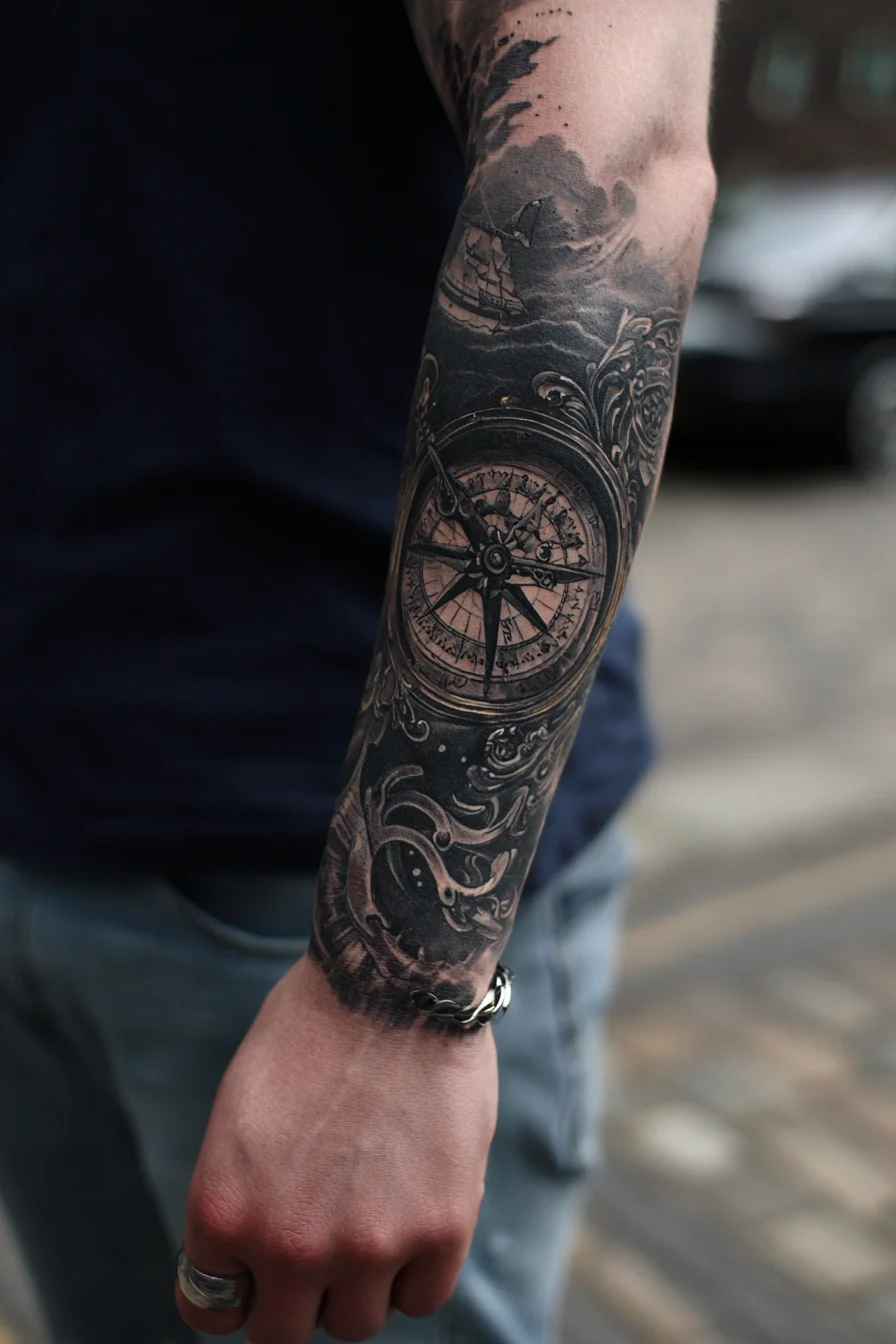
This nautical compass sleeve blends guiding symbolism with maritime imagery: a detailed compass face, ship silhouette and crashing waves framed by ornamental scrollwork. It conveys navigation, purpose and resilience—popular choices for men who want a visual tribute to travel, life direction or overcoming challenges. Placement suggestions: the outer forearm or full forearm sleeve showcases the circular compass and flowing waves best; a half-sleeve extension onto the upper arm or wrist wrap creates continuity. Pain level expectations: overall forearm work is low-to-moderate—outer forearm is among the least painful spots, while the inner forearm, wrist and areas over bone (near the elbow) are more sensitive. Size considerations: to retain crisp compass detail, aim for a larger focal point (roughly 8–12 cm diameter) and plan for multiple sessions for a full sleeve; smaller versions simplify detail and reduce session time. Styling variations: black-and-grey realism or high-contrast blackwork suits the vintage feel; add subtle color washes (teal/sepia), dotwork backgrounds, neo-traditional linework or coordinate/initial accents for personalization. Choose an artist experienced in fine-line shading and texture for best longevity and clarity.
Realistic Skull Forearm Tattoo with Ornamental Filigree and Key Motif
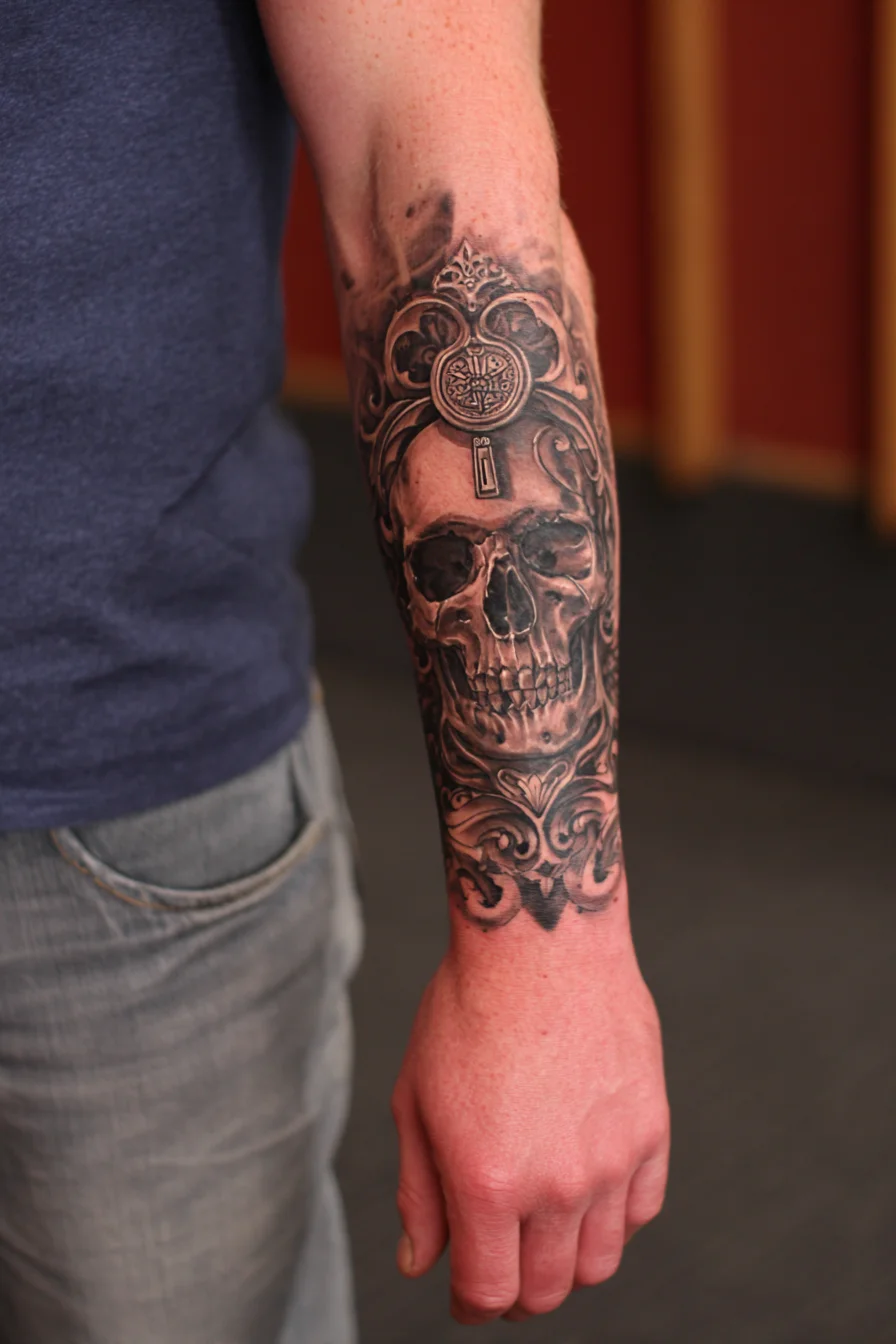
This forearm piece marries a realistic skull with baroque filigree and a key/keyhole motif — symbols of mortality, hidden strength and unlocking personal transformation. It reads bold and masculine while allowing layers of private meaning: resilience, remembrance, or a life chapter closed and reopened. Placement: the outer or inner forearm suits visibility and daily wear; outer forearm highlights toughness, inner forearm is more intimate. The design translates well as a standalone half-sleeve or as the anchor for a full sleeve that flows toward the elbow or wrist. Pain: forearm tattoos are generally moderate in pain. Outer forearm has more muscle and is less sensitive; the inner forearm, near the wrist, and over tendons can be noticeably sharper. Sessions can be split comfortably. Size & detail: to retain realistic shading and filigree detail plan for a medium-to-large canvas — roughly 5–8 inches tall depending on arm size. Smaller versions will lose fine linework. Styling variations: stick with black-and-gray realism for contrast, add subtle color highlights (gold for the medallion, red for gems), or adapt to neo-traditional, dotwork backgrounds, or integrate lettering and timepieces for personal narratives.
Realistic Lion Forearm Tattoo — Black & Grey Wildlife Portrait
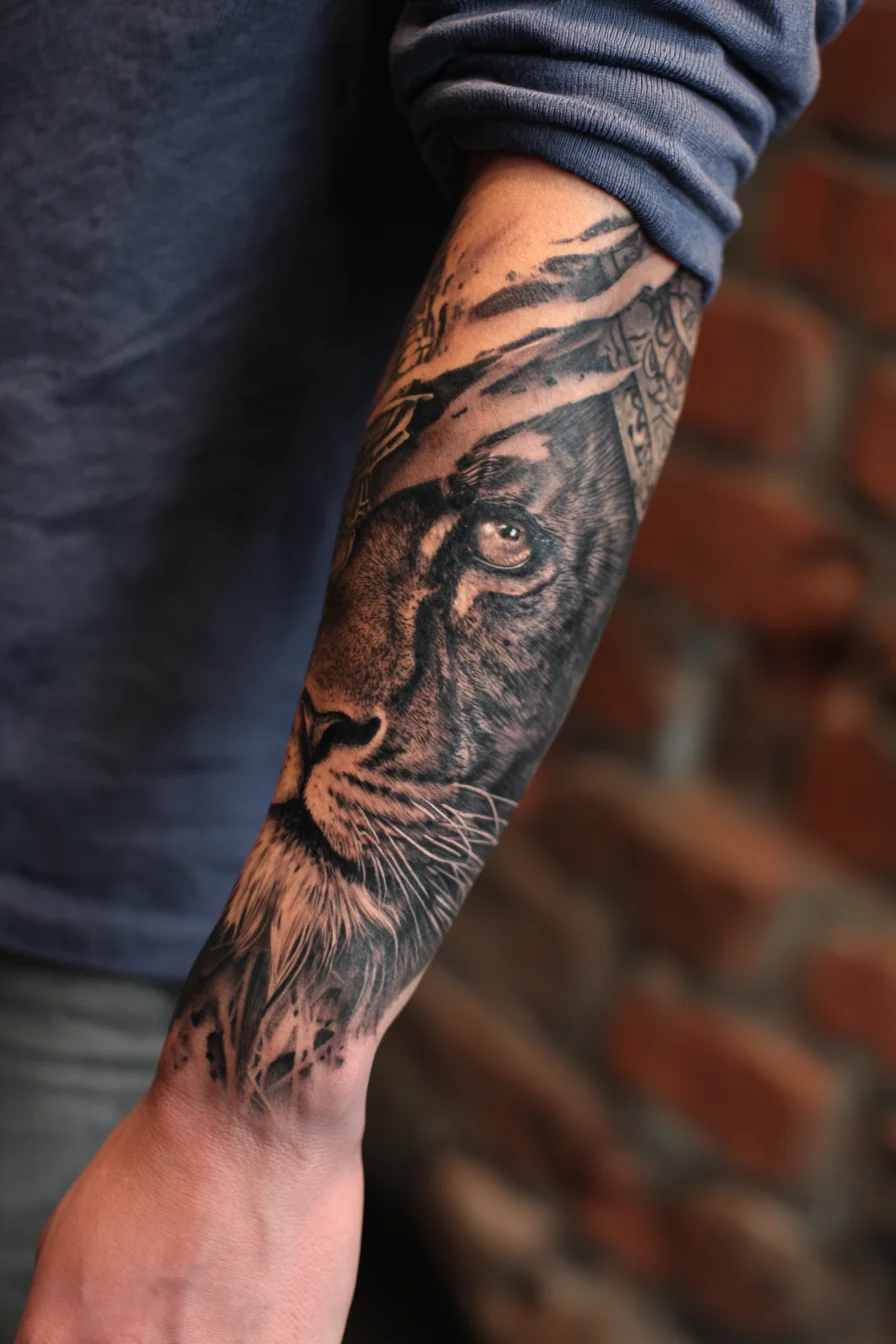
This black-and-grey realistic lion portrait reads as a statement piece: strength, leadership and controlled ferocity. The forearm placement shown is ideal for visibility and elongation of the lion’s face — it works as a standalone from wrist to mid-forearm or as the foundation for a half/full sleeve. Pain is generally low-to-moderate on the outer forearm; expect more sensitivity toward the inner wrist, near the elbow crease and over bony areas. For crisp realism, opt for medium-to-large sizing (roughly 6–10 inches / 15–25 cm) so the artist can execute fine hair strokes, whiskers and nuanced shading; detailed pieces often require multiple sessions. Styling variations include full black-and-grey realism, high-contrast dotwork backgrounds, geometric framing, neo-traditional color accents or selective watercolor highlights to emphasize the eye. Consider adding complementary elements — clock, compass, script or foliage — to personalize meaning and aid sleeve integration. Discuss needle grouping, reference photos and aftercare with your artist; proper contrast and healed skin tone will determine long-term clarity and longevity.
Realistic Black & Grey Lion Forearm Tattoo — Crowned Lion Sleeve Design
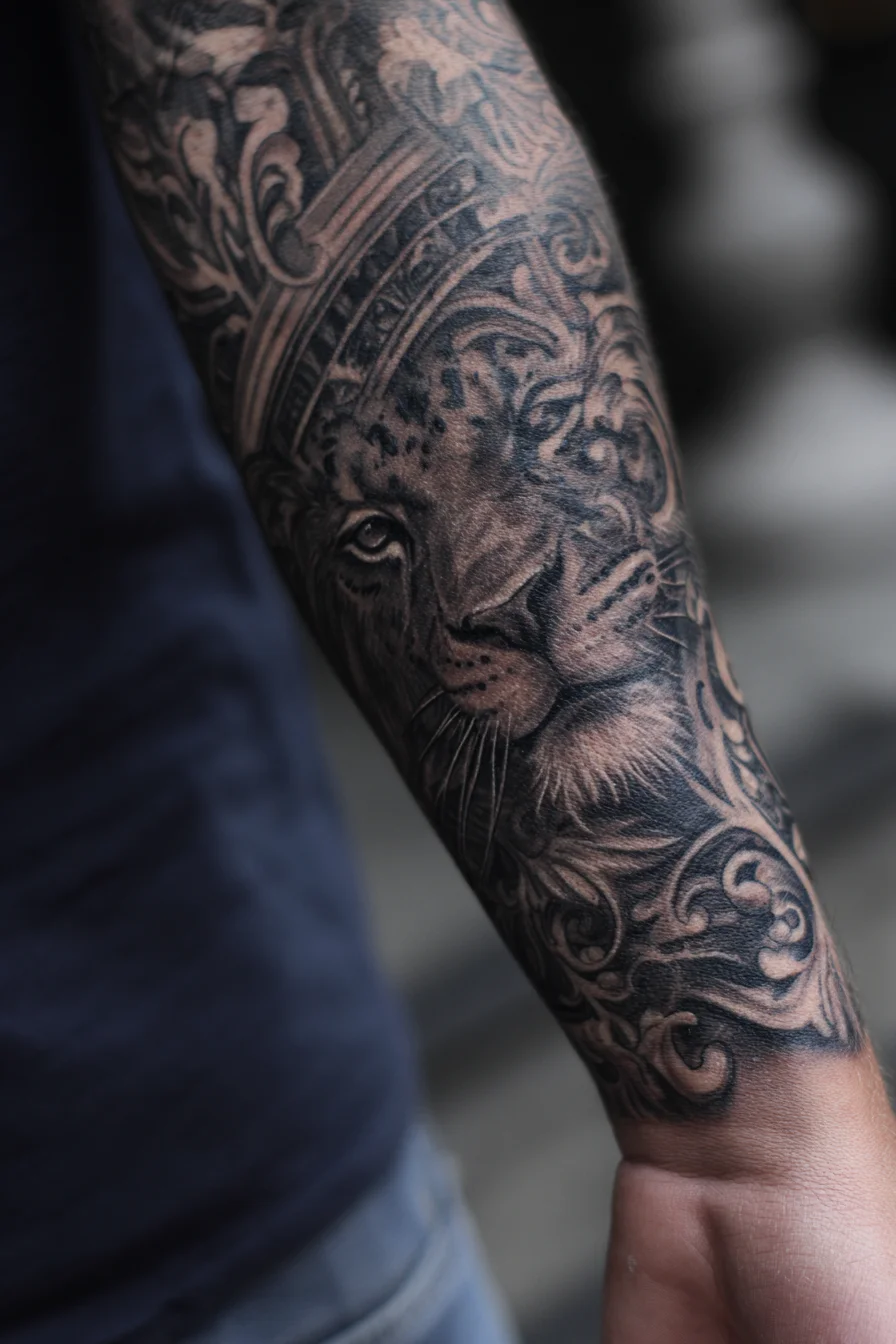
This black-and-grey realistic lion with ornamental filigree and a crown reads as a statement piece about strength, leadership and personal sovereignty. The crown motif adds a layer of authority or triumph to the traditional lion symbolism, while the scrollwork frames the face for a classic, masculine look. Placement suggestions: the outer forearm or full lower-arm sleeve preserves visibility and lets the face sit naturally with the arm’s shape; consider extending into the bicep, shoulder, or chest for a larger, seamless composition. Pain expectations: the forearm is generally moderate — outer forearm is among the less painful spots, while the inner forearm, wrist and areas over bone or near the elbow can be more sensitive. Size considerations: to retain facial detail and shading, plan for medium-to-large work (minimum ~6–8 inches along the forearm, larger for full sleeves); realism requires time and multiple sessions. Styling variations: keep strong contrast and heavier lineweights for longevity, or add selective color (gold crown accents), dotwork backgrounds, geometric overlays, or neo‑traditional elements to personalize the piece. Discuss touch-ups and aftercare with your artist to maintain crisp detail over time.
Realistic Black & Grey Dragon Forearm Tattoo — Mens Sleeve Design
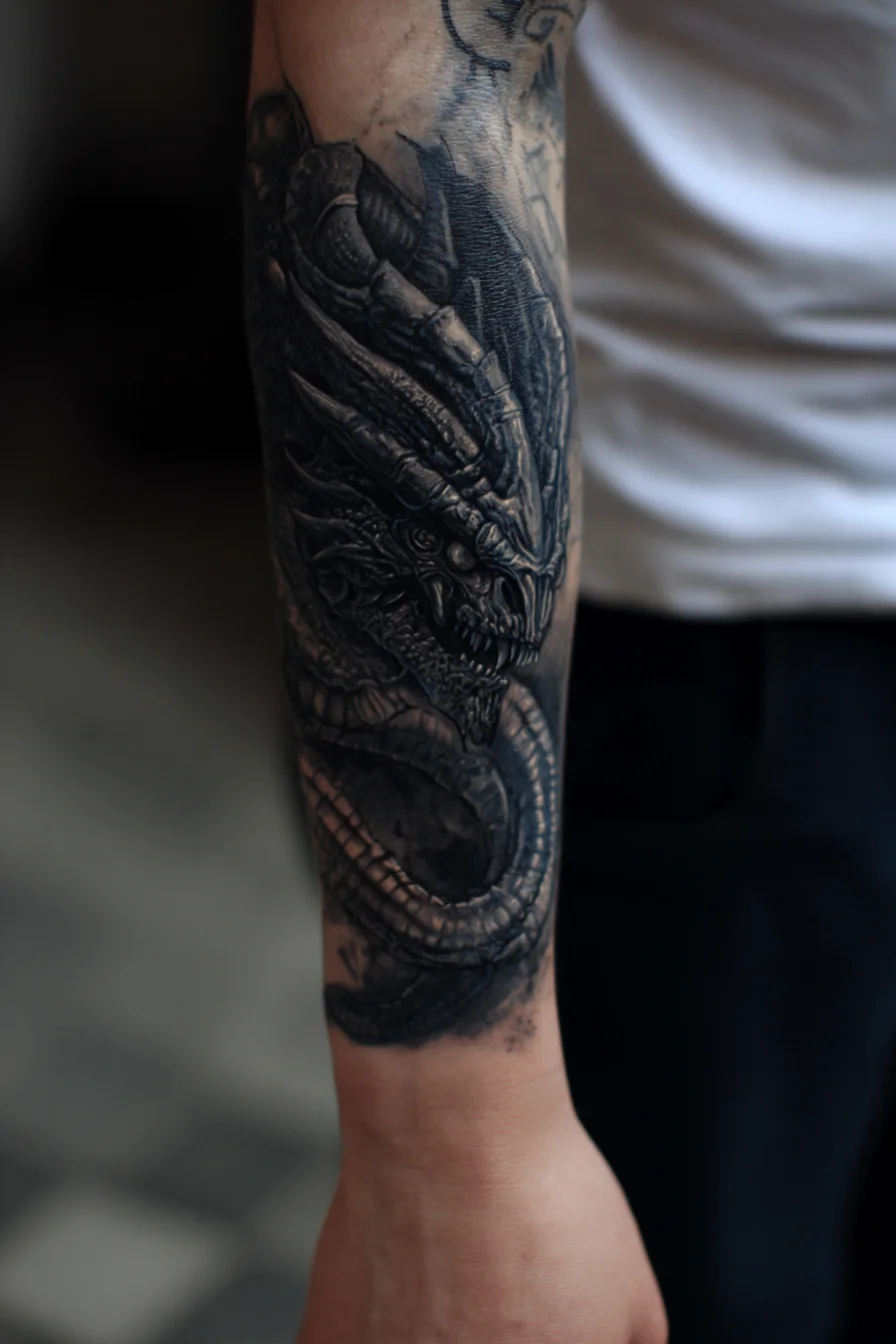
This detailed black-and-grey dragon forearm piece reads as a symbol of strength, protection and controlled ferocity — the coiled, serpentine form evokes movement and a guarded presence. For men seeking bold yet refined body art, the forearm is ideal: it displays well and offers a long, flat canvas for realistic scales, horns and textured shading. Placement suggestions include the outer forearm for visibility, the inner forearm for a more personal piece, or wrapping the design into a half or full sleeve that flows onto the bicep, shoulder or chest. Expect a moderate pain level overall; fleshy outer forearm areas are usually tolerable, while the inner forearm, wrist and near the elbow will be more sensitive. Plan multiple sessions for larger, highly detailed work. Size considerations: larger dimensions (covering most of the forearm) preserve fine detail and depth, while smaller adaptations sacrifice texture and may require simplification. Styling variations to consider: pure black-and-grey realism, high-contrast neo-traditional line work, geometric or dotwork backgrounds, or selective color accents (red or gold) and white highlights to make features pop. Discuss line weight and negative space with your artist for best long-term results.
Forearm Skull & Ship Tattoo — Nautical Black-and‑Grey Sleeve
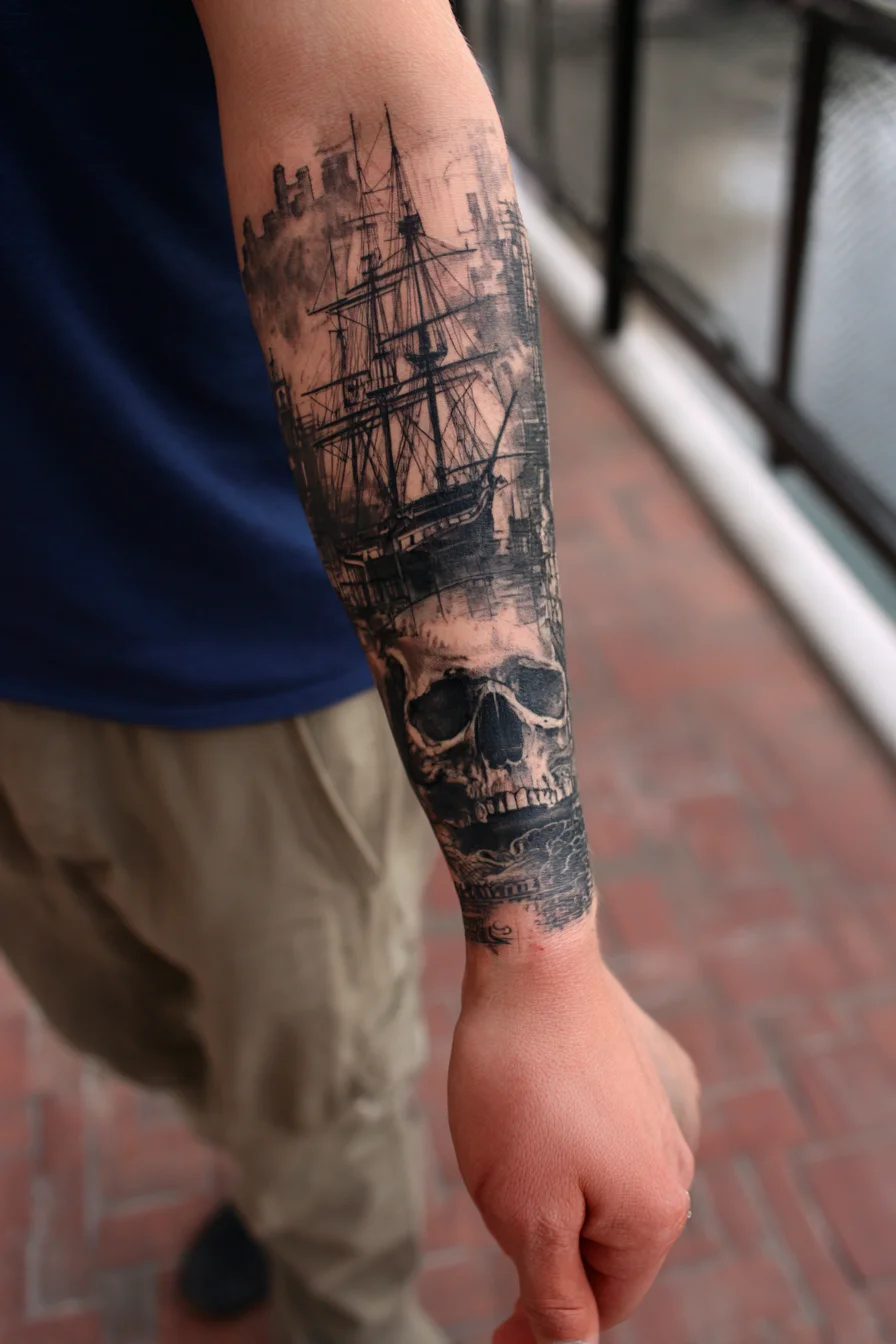
This black-and-grey forearm sleeve blends a weathered sailing ship with a realistic skull to evoke themes of voyage, mortality, and resilience — a classic memento mori with nautical grit. For men seeking a bold statement, the outer forearm is ideal for visibility and flow; the design also wraps nicely into a half or full sleeve, continuing onto the bicep, chest, or calf. Expect moderate pain overall: the fleshy outer forearm is tolerable for most, while the wrist, inner forearm and areas near the elbow are more sensitive. Dense shading in the skull and ship rigging will require longer sessions and precise needlework, so plan multiple appointments. Size matters for legibility — keep this design medium-to-large (roughly 6–10 inches on the forearm) to preserve fine lines and texture; small reductions will lose rigging detail. Styling variations include high-contrast blackwork realism, dotwork backgrounds, distressed/sketch lines, geometric framing, or subtle watercolor accents for wind and sea. Discuss artist specialization, session pacing and aftercare (moisturize, avoid sun and soaking) to ensure crisp healing and long-term contrast.
Lion Forearm Sleeve Tattoo — Realism, Mountains & Forest Motif
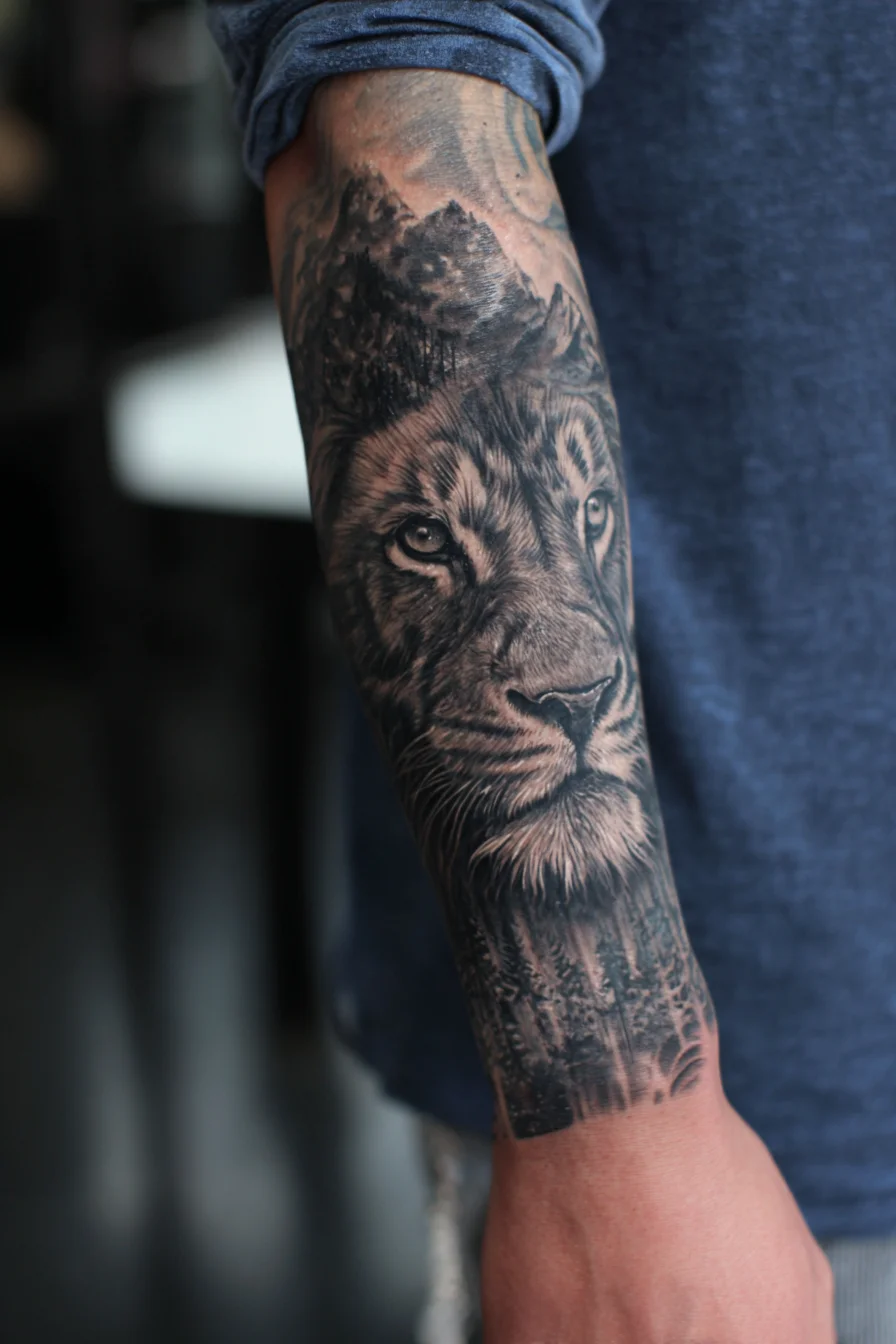
This black-and-grey realism lion forearm sleeve blends a fierce feline portrait with mountain and forest imagery to communicate strength, leadership, and a deep connection to nature. For men seeking a masculine statement piece, the design reads as confidence and resilience — the lion’s steady gaze anchors the composition while the landscape elements add narrative depth. Placement suggestions: outer or inner forearm for visibility and comfort, extending to a half- or full-sleeve across the elbow or wrapping to the bicep for a larger presence; it also adapts well to chest/shoulder or calf placements. Pain expectations: forearm tattoos are generally moderate in discomfort—outer forearm is less sensitive, inner forearm and near the wrist or elbow can be sharper. Size considerations: realism needs room—plan for a medium-to-large canvas (multiple inches tall) to preserve facial detail and subtle shading; large pieces may require multiple sessions. Styling variations: keep strict black-and-grey realism as shown, or add subtle color accents (golden eyes), geometric overlays, dotwork backgrounds, or watercolor washes for contrast. Choose an artist experienced in portrait realism and discuss session pacing and aftercare for best results.
Black & Grey Floral Forearm Sleeve with Eagle — Masculine Tattoo
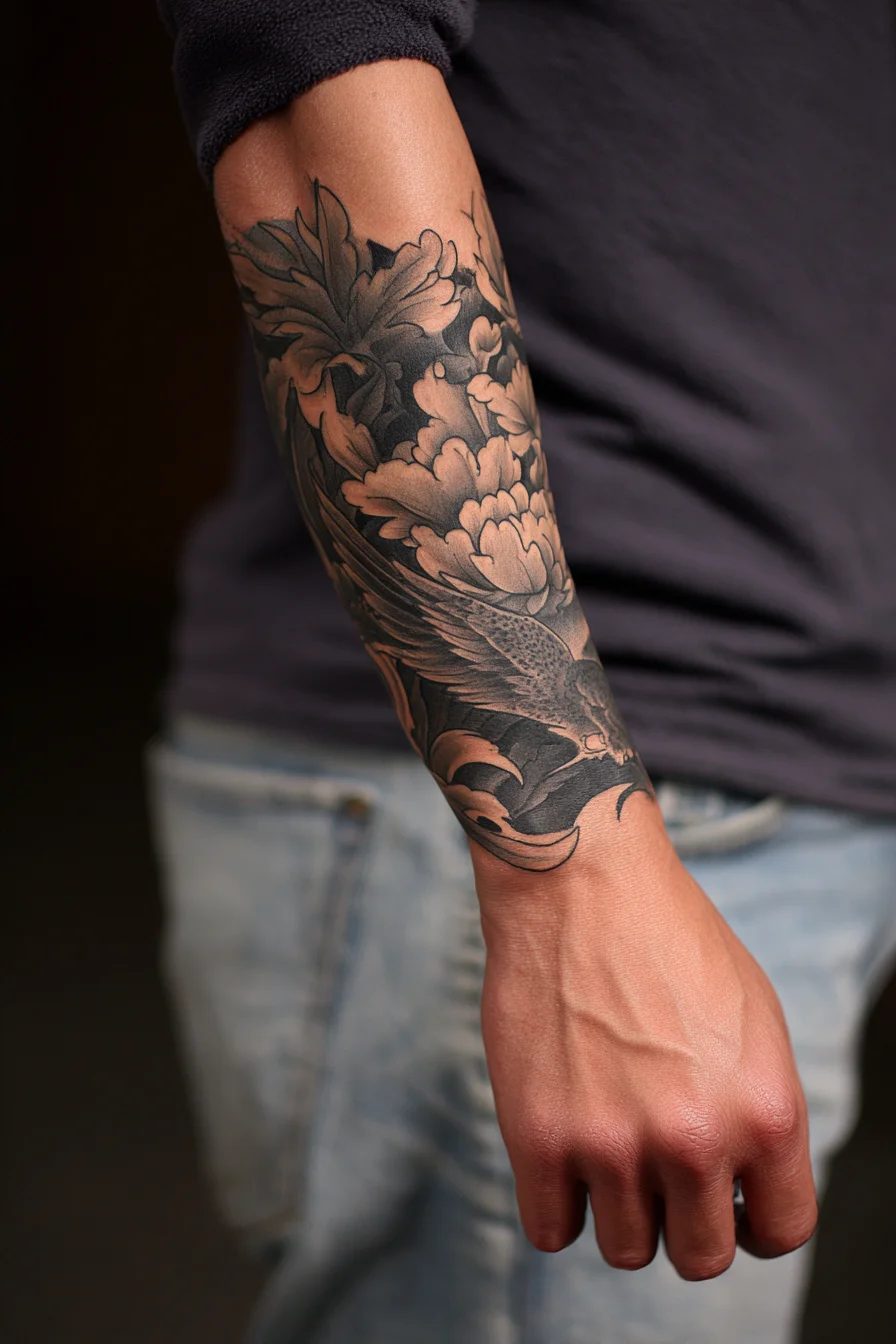
This black-and-grey forearm sleeve combines large ornamental blooms and a swooping eagle to balance strength and refinement — an aesthetic many men favor. Meaning: the floral motifs (peony/ chrysanthemum-style) communicate resilience, honor and growth, while the bird symbolizes freedom, focus and protection. Placement suggestions: ideal on the outer or full forearm as a wrap that follows muscle contours; extend into a half- or full-sleeve by linking the piece to the bicep or wrist. The inner forearm can showcase fine detail but is more visible. Pain level expectations: forearm tattoos are generally low-to-moderate in discomfort — outer forearm is milder, whereas the inner forearm, wrist and elbow crease are more sensitive. Size considerations: choose medium to large scale to preserve floral shading and feather texture—small pieces will lose detail. Leave negative space for contrast and longevity. Styling variations: keep classic black-and-grey for a masculine look, or add selective color accents for focal points; consider neo-traditional linework, realistic shading, or Japanese-inspired bold backgrounds to match personal style and wardrobe.
Baroque Ornamental Forearm Tattoo — Black & Grey Scrollwork
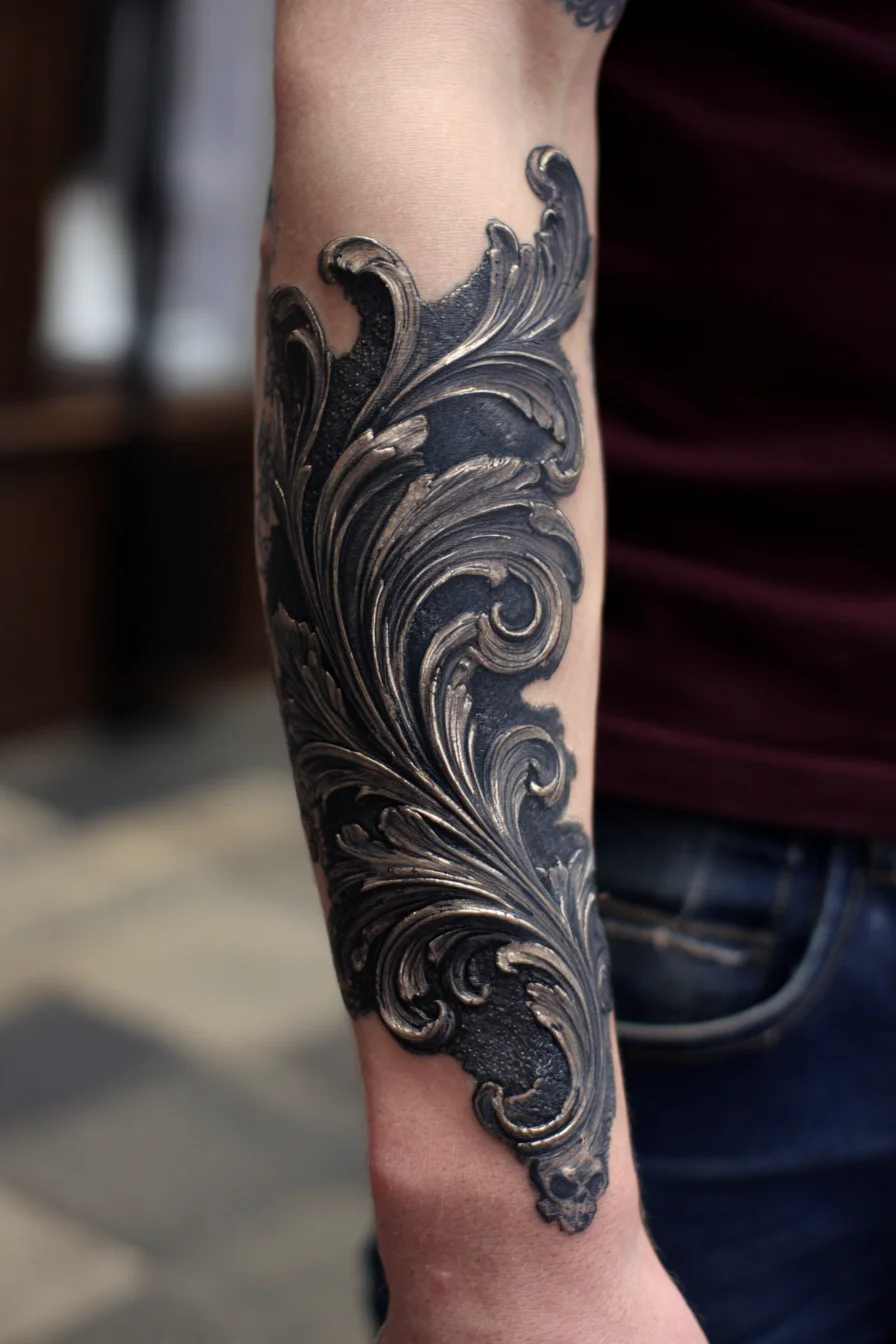
This ornamental Baroque-style scrollwork tattoo reads like carved metal — a bold black-and-grey piece with high-contrast highlights that create a three-dimensional, embossed effect. Meaning: ornamental scrolls often represent strength, refinement and legacy; they work equally well as a standalone statement or as a decorative frame for personal symbols. Placement suggestions: ideal for the outer or inner forearm, where the long vertical flow complements muscle lines; it can wrap slightly toward the wrist or elbow or be extended into a half-sleeve or shoulder piece. Pain expectations: forearm tattoos are generally low-to-moderate in discomfort — the outer forearm is among the least painful areas, while the inner forearm, wrist and directly over the elbow tend to be more sensitive. Size considerations: this design benefits from mid-to-large scale (about 6–12 inches) so carving details and highlights remain legible over time; shrinking it too small will lose texture. Styling variations: classic black-and-grey with white or metallic-gold highlights gives a sculptural look, while dotwork backgrounds, subtle color washes or negative-space patterns modernize the motif. Consult your artist about skin tone, healing and line weight to ensure longevity and contrast.
Realistic Leopard Forearm Tattoo — Black & Grey Half-Sleeve with Tribal Patterns
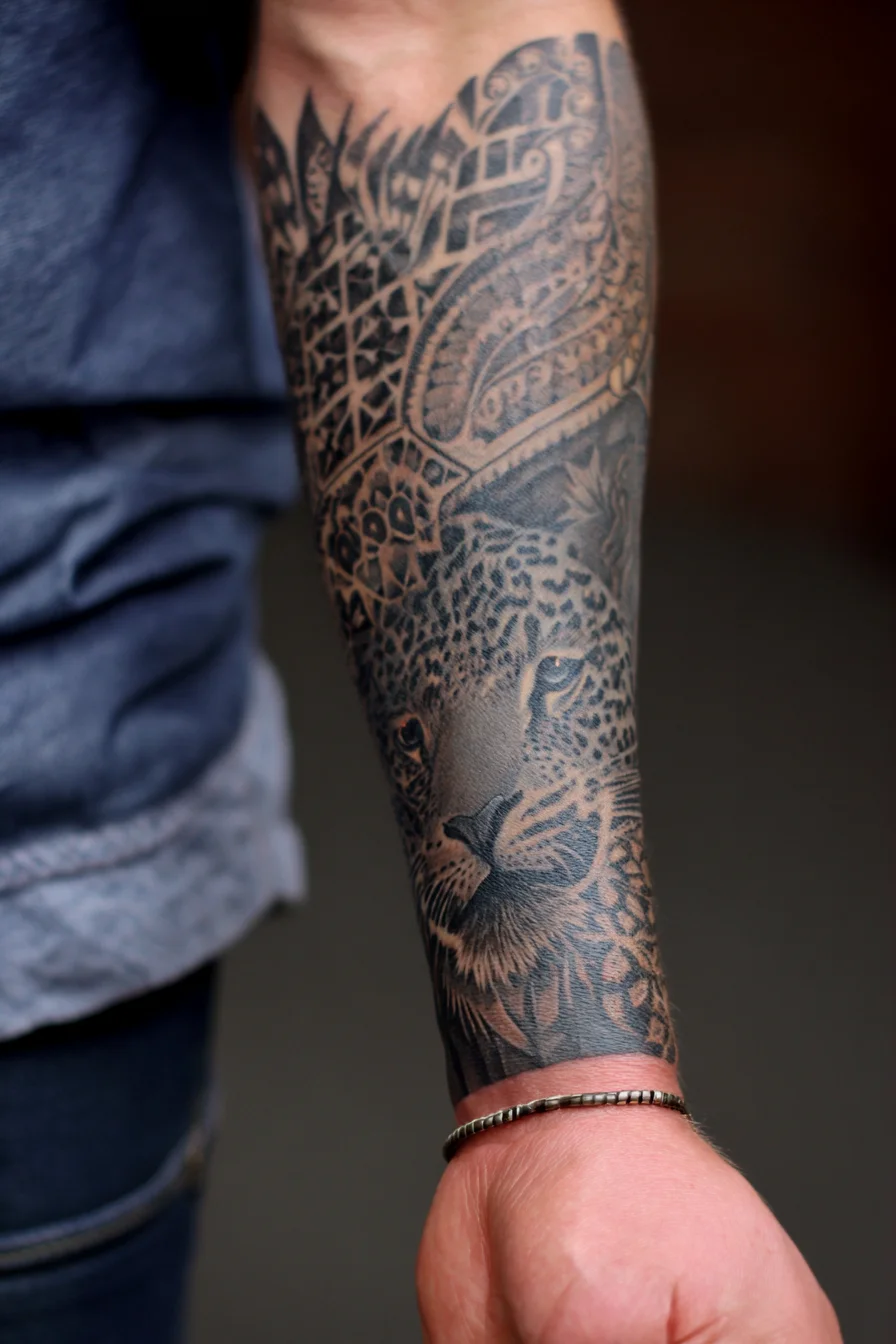
This black-and-grey forearm half-sleeve pairs a realistic leopard portrait with geometric and tribal patterning for a design that reads as strength, stealth, and personal resilience. The leopard symbolizes power, focus, and independence; the patterned upper forearm provides texture and visual flow that helps the piece read from a distance. Placement suggestions: outer forearm for visibility and lower sensitivity, inner forearm for a more intimate look, or extend up toward the bicep/shoulder to create a cohesive sleeve. Pain expectations: forearm work is generally moderate — outer forearm is one of the more comfortable areas, while the inner forearm, wrist and near the elbow can sting more and often require shorter sessions. Size considerations: to preserve facial detail and dotwork, plan for a medium-to-large canvas (roughly 6–10 inches vertically); smaller scales can blur fine textures over time. Styling variations: keep it classic black-and-grey realism, add subtle color highlights (amber eyes, warm tones) or integrate Polynesian/mandala elements for cultural fusion. Expect multiple sessions, strategic spacing for healing, and occasional touch-ups to maintain crisp contrast.
Warrior King Portrait Forearm Tattoo — Clock, Beard, Black & Grey Realism
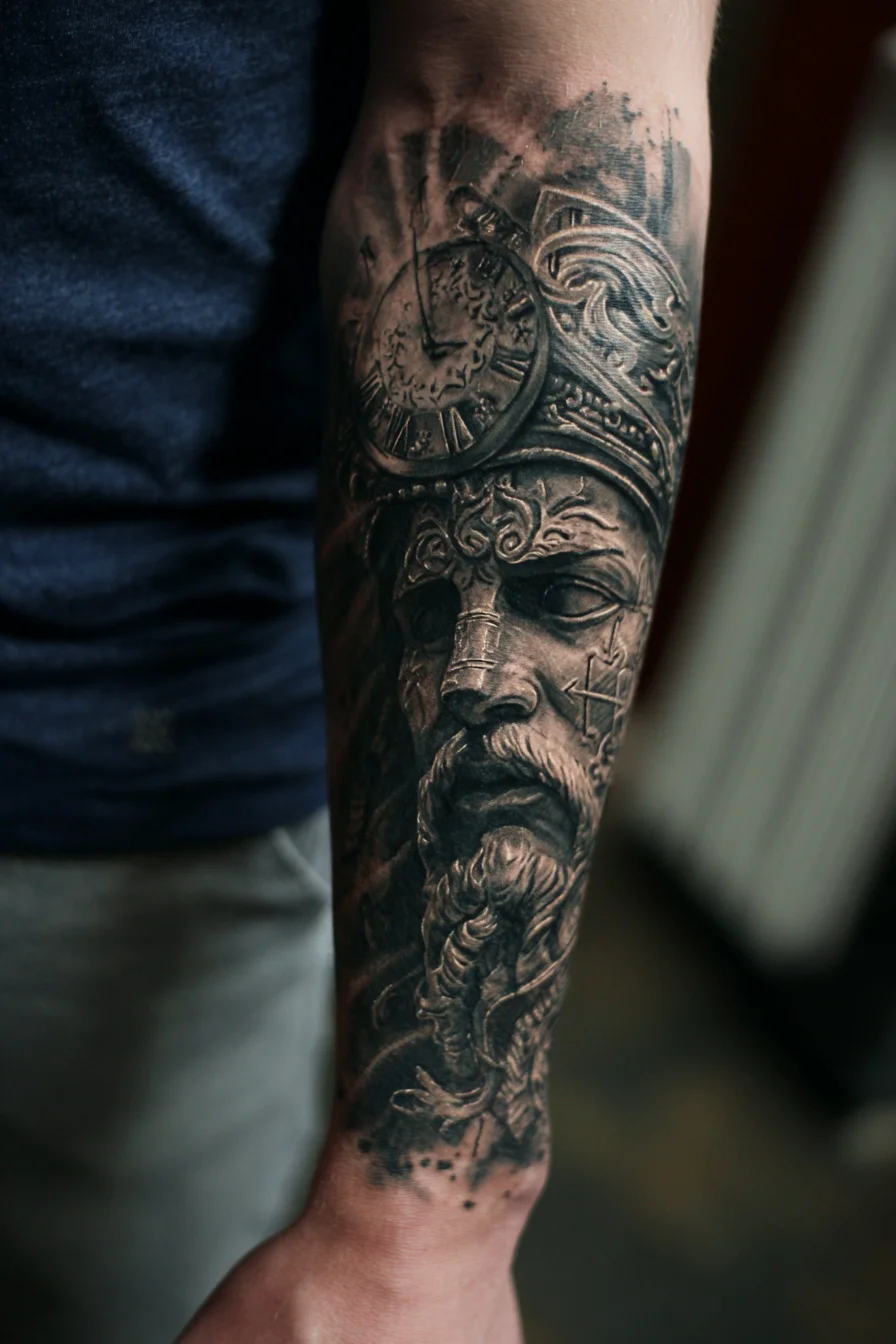
This black-and-grey portrait combines an aged, bearded warrior/king with a vintage clock to communicate themes of time, wisdom, mortality and legacy — a strong motif for men who want a narrative-driven piece. For placement, the outer forearm works exceptionally well for visibility and moderate pain; consider a full forearm sleeve or three-quarter wrap for continuity. Other masculine options include the upper arm, chest panel or calf if you prefer a larger canvas. Expect pain to range from low–moderate on the outer forearm to higher on the inner forearm, wrist and around the elbow where bone and nerve endings sit closer to skin. For crisp facial features and readable clock numerals, plan on a larger scale — typically 6–10 inches for a forearm piece — so fine details and realistic shading don’t blur over time. Styling variations: stick with black-and-grey realism for dramatic depth, add white highlights for contrast, or introduce subtle warm tones (sepia/rust) for an aged look. Alternatives include dotwork backgrounds, geometric framing, or neo-traditional linework to suit a bolder aesthetic.
As a professional consultant, my final advice is to treat a forearm sleeve as a multi-stage project — concept, artist selection, placement mock-up, and staged sessions. Start with a strong focal piece (portrait, symbol, or geometric anchor) and let additional elements build around it so the composition reads from wrist to elbow. Discuss skin tone, line weight, and long-term fading with your artist; dense blackwork ages differently than delicate color. Budget realistically for multiple sessions and follow strict aftercare to preserve detail. If you’re unsure about visibility at work or future cover-up needs, request a placement stencil and wear-test before the needle. Use the 16 gallery images in this post to clarify your preferences and bring framed references to your consultation. If you want, I can review your selection and suggest refinements based on flow, contrast and longevity. — Hakan
